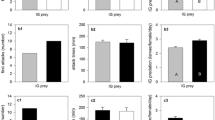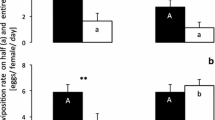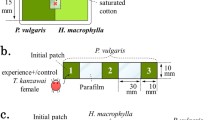Abstract
We recently reported evidence for increased diapause incidence in the spider mite Tetranychus urticae in presence of the predatory mite Typhlodromus pyri. This effect may arise from (1) selective predation on non-diapause spider mites, (2) predator-induced diapause in spider mites, or (3) both. Using a different strain of T. urticae, we first recovered increased diapause incidence in association with predators. Then, we tested for selective feeding in two-choice experiments with equal numbers of non-diapause and diapause spider mites. We found that the predatory mite had a significant preference for the latter. This indicates that increased diapause incidence in association with predatory mites is not due to selective predation. Therefore, predator-mediated physiological induction of diapause seems a more likely explanation. The cues leading to induction appear to relate to the predators, not their effects, since predation simulated by spider-mite removal or puncturing did not significantly affect diapause incidence. Why spider mites benefit from this response, remains an open question.
Similar content being viewed by others
References
H.B. Boudreaux (1963) ArticleTitleBiological aspects of some phytophagous mites Annu. Rev. Entomol. 8 137–154 Occurrence Handle10.1146/annurev.en.08.010163.001033
A.F.G. Dixon (1998) Aphid Ecology Chapman & Hall London
A.F.G. Dixon B.K. Agarwala (1999) ArticleTitleLadybird-induced life-history change in aphids Proc. Roy. Soc. Lond. B 266 1549–1553 Occurrence Handle10.1098/rspb.1999.0814
G.G. Kennedy D.R. Smitley (1985) Dispersal W. Helle M.W. Sabelies (Eds) Spider Mites: Their Biology, Natural Enemies and control, Vol. 1A Elsevier Amsterdam 233–242
D.S. Koveos A. Kroon A. Veerman (1993a) ArticleTitleGeographic variation of diapause intensity in the spider mite Tetranychus urticae Physiol. Entomol. 18 50–56
D.S. Koveos A. Kroon A. Veerman (1993b) ArticleTitleThe same photoperiodic clock may control induction and maintenance of diapause in the spider mite Tetranychus urticae J. Biol. Rhythms 8 265–282 Occurrence Handle1:STN:280:ByuA3crhvFc%3D
Kroon A., Veenendaal R.L., Bruin J., Egas M. and Sabelis M.W. 2004. Predation risk affects diapause induction in the spider mite Tetranychus urticae. Exp. Appl. Acarol. in press.
J.A. McMurtry C.B. Huffaker M. Vrie van de (1970) ArticleTitleEcology of tetranychid mites and their natural enemies: a review. I. Tetranychid enemies: their biological characters and the impact of spray practices Hilgardia 40 IssueID11 331–390
W.P.J. Overmeer (1981) ArticleTitleNotes on breeding phytoseiid mites from orchards (Acarina: Phytoseiidae) in the laboratory Med. Fac. Landbouww. Rijksuniv. Gent 46 IssueID2 503–509
S.Y. Popov A. Veerman (1996) ArticleTitleBehavioural response and winter survival of mated and unmated diapausing females of the Tetranychus atlanticus-urticae complex (AcariTetranychidae) Exp. Appl. Acarol 20 167–175 Occurrence Handle10.1007/BF00051482
M.W. Sabelis P.M. Bakker (1992) ArticleTitleHow predatory mites cope with the web of their tetranychid prey: a functional view on dorsal chaetotaxy in the Phytoseiidae Exp. Appl. Acarol. 16 203–225 Occurrence Handle10.1007/BF01193804
A. Veerman (1974) ArticleTitleCarotenoid metabolism in Tetranychus urticae Koch (Acari: Tetranychidae) Compar. Biochem. Physiol. 47 101–116 Occurrence Handle10.1016/0305-0491(74)90095-9 Occurrence Handle1:CAS:528:DyaE2cXotVaktw%3D%3D
A. Veerman (1985) Diapause W. Helle M.W. Sabelis (Eds) Spider Mites: Their Biology, Natural Enemies and Control, Vol. 1A Elsevier Amsterdam 279–316
W.W. Weisser C. Braendle N. Minoretti (1999) ArticleTitlePredator-induced morphological shift in the pea aphid Proc. Roy. Soc. Lond. B 266 1175–1181 Occurrence Handle10.1098/rspb.1999.0760
J.H. Zar (1999) Biostatistical Analysis. 4th edn Prentice Hall Upper Saddle RiverNew Yersey, USA
Author information
Authors and Affiliations
Corresponding author
Rights and permissions
About this article
Cite this article
Kroon, A., Veenendaal, R.L., Egas, M. et al. Diapause incidence in the two-spotted spider mite increases due to predator presence, not due to selective predation. Exp Appl Acarol 35, 73–81 (2005). https://doi.org/10.1007/s10493-004-1980-x
Received:
Accepted:
Issue Date:
DOI: https://doi.org/10.1007/s10493-004-1980-x




